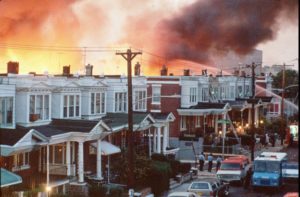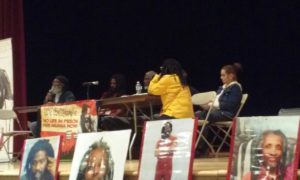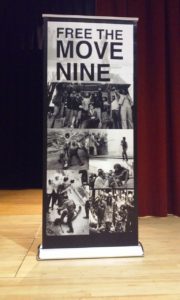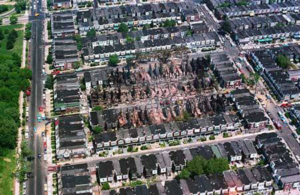 “Carlos [Africa] was expressing the hurt that all MOVE people felt, after the hurt, the slaughter of our family,” said Mama Ramona Africa, the lone adult survivor of the May 13, 1985 bombing of the MOVE house on Osage Avenue, an assault that featured thousands of rounds of ammunition, the use of an incendiary device on the roof, and a blaze that consumes an entire city block and ultimately sealed the fate of six adults, five children, and an untold number of pets in the MOVE house. “The point is, we are living beings. We are alive. So we have feelings. And thanks to the understanding John Africa had given us, we’re not confused about strength and feelings. Showing no feelings, feeling nothing, is not strength. When you have feelings, that’s what makes you strong. So what I’m telling you is, MOVE people are living beings that have feelings, thanks to John Africa. We can be hurt, because we have feelings. We can feel hurt. But goddammit, we won’t be stopped. We can be hurt, but we won’t be stopped, and that’s what’s important.”
“Carlos [Africa] was expressing the hurt that all MOVE people felt, after the hurt, the slaughter of our family,” said Mama Ramona Africa, the lone adult survivor of the May 13, 1985 bombing of the MOVE house on Osage Avenue, an assault that featured thousands of rounds of ammunition, the use of an incendiary device on the roof, and a blaze that consumes an entire city block and ultimately sealed the fate of six adults, five children, and an untold number of pets in the MOVE house. “The point is, we are living beings. We are alive. So we have feelings. And thanks to the understanding John Africa had given us, we’re not confused about strength and feelings. Showing no feelings, feeling nothing, is not strength. When you have feelings, that’s what makes you strong. So what I’m telling you is, MOVE people are living beings that have feelings, thanks to John Africa. We can be hurt, because we have feelings. We can feel hurt. But goddammit, we won’t be stopped. We can be hurt, but we won’t be stopped, and that’s what’s important.”
The MOVE Conference was held on Friday, May 5, Saturday, May 6 and Sunday, May 7 at the Universal Audenreid Charter High School in Philadelphia, Pennsylvania. The three-day event featured several panels of MOVE members and supporters who provided information to the attendees about the MOVE Organization, its founding by visionary leader John Africa (“The Coordinator”), its history of resistance to police intimidation during the regime of police commissioner and later mayor Frank Rizzo, repeated police brutality incidents including the death of baby Life Africa, the August 8, 1987 attack on the MOVE House in Powelton Village, the resurgence of MOVE at 6221 Osage Avenue in the Cobbs Creek area of the city, and the May 13, 1985 confrontation that left eleven people dead and 61 homes burned to the ground.
Carlos Africa, one of the organization’s strongest advocates at public events who regularly speaks in support of Mama Ramona and Mama Pam Africa, elaborated on Mama Ramona’s point about the organization, or “family” as it is commonly known, deriving their strength from the deep feelings they all share, especially the parents of children who died in the 1985 bombing. “Also I want to point out that all the men, move men in state prison, the women were a big factor. … Delbert, Rhea, Janine, Phil [who sadly passed on to the Ancestors while imprisoned as part of the MOVE Nine in January 2015–Editor], Janet, they all had kids in that house. … MOVE women, they’re a foundation of our organization. They’re a big part, and that’s why I’m still here, and the rest of our brothers and sisters are still here, and why all these young people … that were born in this organization, that’s why they’re here. Because the wisdom and teachings from John Africa, that were passed on to our sisters by the ones who had babies in the early years, like Rhea, Janet, Consuela, Janine. The majority of the kids you see up here, they were born in our house in southwest Philly. And most of them don’t have birth certificates, just like Life Africa didn’t have a birth certificate when they claimed that Life Africa wasn’t murdered by the police when Janine had him in her arms back in 1976. …” Janine Africa, now imprisoned for a term of 30 to 100 years as one of the MOVE Nine stemming from the August 8, 1978 attack in Powelton Village, was holding baby Life Africa in her arms during a 1976 police raid when she was jostled, the baby was knocked from her arms and hit the pavement, resulting in a fatal skull fracture that to this day is denied by the Philadelphia police department.

Abdul, Mike Jr, Levi, Ramona, Rhea Africa. Hidden behind Ramona: Carlos Africa.
Barbara Grant, Journalist, on the Osage Avenue Attack
Radio journalist Barbara Grant was working for radio station WDAS at the time of the Osage Avenue attack. She spoke to the audience about her experience attempting to give fair coverage to MOVE and her recollections of the day of the bombing.
“It’s not something that I talk about a lot, and hearing Carlos just brought back some painful memories, (but) that we-won’t-ever-be-defeated kind of spirit, really kind of gives us all strength. I was at WDAS at the time that the MOVE bombing happened as the news director. … What WDAS did, from ’78 onward, was to try to be a counterbalance between what was actually happening and what was being reported in the mainstream media, and we did that for a couple of reasons. One, because Mumia [Abu-Jamal, perhaps the most famous Political Prisoner in the world and an unflinching supporter of MOVE from that time to the present day–Editor] was one of us. Mumia was part of the WDAS news staff at one time. And the other was because, as the voice of the Black community, and taking that really, really seriously, this idea of injustice was at the top of our agenda, in terms of making sure that people were reported on in a fair way, and so, what my news director said to me when I first showed up there, was ‘If we don’t show MOVE people to be people, they will never appear like that in the mainstream media. No one else will do it.’ So we really tried to make sure that our connection to MOVE was a live one and a dynamic one. And I remember using reels and reels of tape–at that time we had the tape on the big reels–to allow MOVE people to have their say, and to allow opportunities for people to speak in their own voices. Because it just wasn’t being reported in the mainstream press. When there were so many misconceptions and purposeful instances of misinformation being put out there about the MOVE Organization. Just one example, people wanted to describe MOVE children as being unkempt, and starved, and dirty, and all of these things, and when you really knew the truth, you knew that these were some of the healthiest children in the city, because of their diet and their lifestyle, and there were things like that that needed to come out, which allowed people to have 1985 happen, because they dehumanized MOVE and they isolated MOVE, and because it was easy for readers, listeners, viewers, to really think that ‘We’re not like them’. That these are not even human beings, that these are not people. And so, when [an audience member] asked the question before of what people think, what we say to folks when they say ‘well, why should I give a damn about it’, it’s because people don’t think that they’re sitting on the same square as folk from MOVE. And yet, what we see in the federal government right now, is that we’re all on the same damn square. It’s like, how do you deal with lies, when you believe in the truth? How do you not get confused about that, when it’s coming out of the mouth of the orange person in the White House?
“But, what I experienced in terms of 1985, I guess, started, on Mother’s Day. We knew something was going on on Osage avenue, and we were watching for it, in the run-up to May 13, and the Sunday before that, it was Mother’s Day. And I remember I was having dinner with my son and husband who took me out to dinner, and Vera Martin called me, and said ‘this is getting ready to go down.’ And so I said to my family. ‘I’ll be back in a little while’, and I went to go check on things and we didn’t get back foe three days. It was just like that, bam-bam-bam, what was happening.
“And I remember the night that they were moving everybody out of their houses, and moving in the apparatus, the equipment, the crews that were disconnecting gas, disconnecting the water, and disconnecting the electricity, and saying to people, ‘well, you just have to go for a couple of hours, and we’ll let you back in the house’. And at some point that evening, it got really, really clear that something really bad was getting ready to happen. And so, I called the Mayor’s Office, and had a friend in there, and told that person that this was going to end up badly, and that there were real intentions on the part of public officials and the police specifically, because this was a police operation, and everyone else in the city, even the fire department, abdicated to the police. I just talked to someone the other day about this, and they said the person that they held most responsible for what happened on Osage avenue was the fire commissioner [William Richmond, who was found responsible for the use of excessive force by a jury in a lawsuit eleven years later, along with police commissioner Gregore Sambor and the City of Philadelphia–Editor], because the fire commissioner should have said to the police commissioner [Sambor], ‘F you, I have to fight this fire.'”
“I called the Mayor’s Office, and had a friend in there, and told that person that this was going to end up badly, and that there were real intentions on the part of public officials and the police specifically. … And after a little while, they came back and they said, ‘the Mayor said, and I quote, there’s nothing he can do.’ There’s nothing he can do.“
Mama Ramona Africa pointed out, “One thing I’ve always been telling people, when they came out there, they [police] can label it a crime scene. But at the point there is a fire, that is the jurisdiction of the fire department, and the police commissioner cannot tell the fire commissioner how to or not to fight a fire.”
Ms. Grant continued, “That’s absolutely the truth, and I don’t want to take up too much time, but at some point that night, that did happen. And I did call the Mayor’s Office, and what was told to me was ‘okay, hold on, I’m going to go check with the Mayor.’ And after a little while, they came back and they said, ‘the Mayor said, and I quote, there’s nothing he can do.’ There’s nothing he can do. The Mayor can always do something. The Mayor can always do something, the Mayor is in charge, unless you abdicate to the police commissioner, which was what was done.
“And so, as that evening went on, the other incident was that the MOVE folk in the house actually called for a contingent of reporters to negotiate. they were ready to talk to people about how to resolve this in a way that wouldn’t result in a catastrophe. I was one of those folk, and so I went to the cops at the barricades, and tried, on several occasions, in several different places, to tell them, I wanted to speak with them. I’m not trying to be a hostage, but folk are calling for some avenue that will keep whatever it is you’re getting ready to do from happening. And basically, I was just tossed off, as I’m sure Harvey Clark, and some of the other folk that were called for were as well. So they had no intention of trying to negotiate, they had no intention of trying to resolve this, they had decided what they wanted to do. And I don’t know if you’ve heard from the [at the time] photographer at channel 10, who holed up, he hid himself in a house across the street and was photographing some of this. at some point, some of the tape that he collected had a statement in it that I will never, ever forget for the rest of my life, which was a couple of cops laughing back and forth with each other, saying, while the fire was burning, ‘this is the last time they’ll call the police commissioner a motherf***er.'”
“[T]he MOVE folk in the house actually called for a contingent of reporters to negotiate. they were ready to talk to people about how to resolve this in a way that wouldn’t result in a catastrophe. I was one of those folk, and so I went to the cops at the barricades … And basically, I was just tossed off … So they had no intention of trying to negotiate, they had no intention of trying to resolve this, they had decided what they wanted to do.”
Mama Ramona corroborated the videotape’s existence, pointing out: “And that’s on a police videotape, and when subpoenaed during my criminal trial [As the only adult survivor of the conflict, she was tried for incitement to riot and other offenses, and was sentenced to jail time, making her the only person prosecuted as a result of the MOVE bombing–Editor], the police said they only had 13 minutes of tape, when they taped from May 12 to May 13. But the thing about it, they’re so stupid, that statement was on their tape that they gave them.”
Ms. Grant continued, “And it came out in evidence during the MOVE Commission [the Philadelphia Special Investigation Commission, which issued a report on March 7, 1986 about the confrontation]. And so, a little bit of fast forwarding, we went through that night, and I remember being near the back alley, on I think this would have been 62nd and Pine, when, as it turned out, Birdie [Africa, also known as Michael Ward], as he testified during the MOVE Commission, said that people were coming out, and him saying ‘we’re coming out, we’re coming out!’ And you couldn’t hear anything, you couldn’t hear anything, that fire was raging, and there was all the noise. It was everywhere. And at the end of it, Ramona and Birdie came out, and that was it.
“And then, when people began to investigate all that stuff, I ended up doing an investigation with, at that time I was with Channel 29, and did a joint investigation with the Legal Intelligencer, about what happened in the back alley, because promises were made about what was supposed to happen on that site. And one of the promises that was made, were that cops that were involved in 1978 weren’t supposed to be anywhere near what was going on on Osage avenue. And it turned out that some of those cops were actually in the back alley.
“The ones that beat Delbert,” said Mama Ramona.
Ms. Grant continued, “And so, as we looked at some of that stuff, and got hold of FBI files, photos, and things like that, we went to talk to a medical examiner who was at that time up in Pittsburgh. And what we discovered, in the end, was that fragments of the bullets that were shot in that back alley ended up in the remains of the MOVE people. [This backs up not only the account of Mama Ramona that MOVE members were shot at when they tried to exit the burning building, but also the account of a retired police officer who lived on Osage Avenue during an interview we conducted in April 2000 that bullet fragments were found in the bodies–Editor.] And that’s kind of the bottom line right there. There were cops in that back alley, that were not supposed to be there to begin with, who did some things that maybe will never, ever see the light of day in the proper way. But I will say this, because I happen to be a believer in God, that some of those police officers ended up committing suicide, some of them ended up as substance abusers, and some of them ended up just not being very happy, peaceful people. And what I believe is that karma is karma.”
 Bro. Kareem Speaks About Learning of the MOVE Bombing
Bro. Kareem Speaks About Learning of the MOVE Bombing
“I’m a MOVE supporter. I’ve been one since 1979. I met MOVE in Holmesburg Prison [in Philadelphia–Editor]–the five men who were awaiting trial for the August 8, 1978 raid on their headquarters. I had come down from Western State Penitentiary. I had gotten a new trial on the case that I had gone to jail for. I had seven years in, and I had been following MOVE up to that point. Like many of you all, I had read a smear campaign about MOVE, that they were dirty, that they ate garlic, like there’s something wrong with eating garlic, that they didn’t take baths, that they used profanity, that they had their children born at home, like there’s something wrong with the children born at home. And I had heard all these things about MOVE, and I considered myself a revolutionary. I was in jail for trying to break some brothers out of Holmesburg prison, and a policeman there got shot. So, I was a political prisoner, I had looked at myself as a political prisoner, and I looked at MOVE as political prisoners. so, on my seventh year while in solitary confinement for trying to escape, I had longed to meet MOVE. I had wanted to meet these brothers and sisters for years. So finally I got a new trial, I had been given an opportunity to go back down to Holmesburg prison, from Western State Penitentiary, which would allow me then to meet MOVE. I went down there. I met MOVE. The first MOVE member I met was Phil Africa, who is now deceased. And from that point on, I remained in MOVE.
But I wanted to speak on May the 13th, 1985. You all might need to forgive me at some point, because I get really emotional about it. On May the 13th of ’85, I was walking the yard, I was the only MOVE prisoner at Graterford Prison at the time. and guys were running up to me telling me, ‘Hey, you heard what happened man? they’re rolling on your family, they’re rolling on MOVE on Osage Avenue.’ So I went back to my cell, turned the TV on, watched until I couldn’t watch anymore. Guys were still coming to my cell door, trying to let me know what was going on until I didn’t want to hear no more. That night, 12 o’clock at night–the jail locks up at 9 o’clock at night in most state prisons–that night, I looked up, I’m laying in bed, I couldn’t sleep. The cell door slams open, and there’s maybe ten guards coming into my cell, saying ‘Come on, you’re coming with us.’ And I’m like ‘Coming with you all where?’ And they say ‘Just come on, that’s all.’ So I said ‘I’m not going nowhere.’ So, I went off on them. I said ‘f*** you motherf***ers, you killed my family, I ain’t hearing nothing you all got to say,’ and I started fighting. They knocked me out, they took me down to the hole, solitary confinement, placed me in the hole, gave me an assault on four different guards, gave me a year in the hole. I stayed in Graterford for six months. And just out of nowhere they ship you in the state prisons, they don’t tell you where you’re going. Just early in the morning, thrown into a van or whatever transportation it is, and they take you to another prison. Well, it was a blessing in disguise for me, because they took me up to Huntington State Prison. And that’s where Mumia was on death row at the time, which gave me the opportunity to communicate with him, as I went from one hole to the other, and Mike Africa was in population. I didn’t know at the time, when they came to my cell door to get me, that they had rounded up all the MOVE members all across the state. I didn’t know that. Put them all in solitary confinement. And for what? For nothing. We didn’t do anything. The fact that we were in MOVE was enough for them. That’s all they needed to know. So I came out, went in population, stayed with Mike until I went home. … I stayed with Mike maybe six months, and then went home. But like Ramona was telling you all, and I want to emphasize to all of you all, MOVE people got feelings. … I can’t say anymore.
Carlos Africa elaborated a bit. “I want to point out that Kareem came home from prison in 1982. He did after he did his 10 or 11 years. And he lived around, not in the house but he lived up around the Osage family for them years right before May 13th, when he was arrested. He was around the kids, he was around the women, and men that were in Osage Avenue. And he got to be real close to them because he felt the same thing other MOVE members felt when we first came into the organization, the love and the concern for family that John Africa instilled in all MOVE people. And any time Kareem talks about it, he does get emotional, because that’s the last time he got to see them, and it’s hard. It’s hard. Thank you. Long Live John Africa.”

The Osage Avenue neighborhood after the MOVE Bombing.
For more information on MOVE, check out other articles we’ve posted here on the Organization, specifically last year’s remembrance of the Osage Avenue bombing and the interview we did in April 2000 with a group of men who were neighbors of MOVE at the time of the Osage Avenue assault and who, despite their opposition to many of MOVE’s methods, had to agree that the family was subjected to a murderous, obscene assault on that day, and there was more to the misconduct and malfeasance of the city of Philadelphia than meets the eye. Also, check out MOVE’s web site, http://onamove.com.
